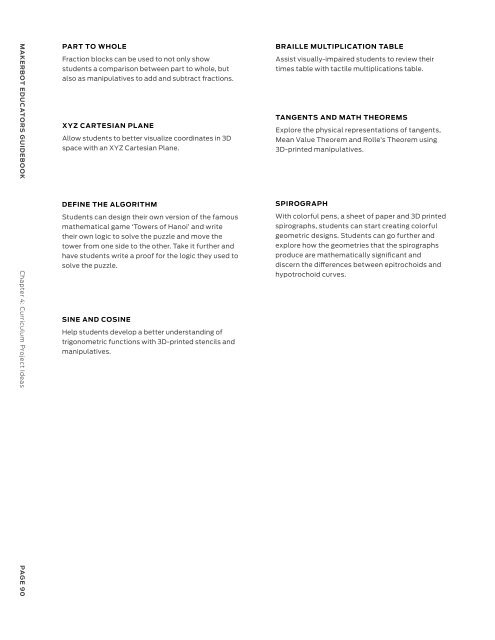MakerBot Educators Guidebook 3rd Edition
Create successful ePaper yourself
Turn your PDF publications into a flip-book with our unique Google optimized e-Paper software.
MAKERBOT EDUCATORS GUIDEBOOK Chapter 4: Curriculum Project Ideas<br />
PAGE 90<br />
PART TO WHOLE<br />
Fraction blocks can be used to not only show<br />
students a comparison between part to whole, but<br />
also as manipulatives to add and subtract fractions.<br />
XYZ CARTESIAN PLANE<br />
Allow students to better visualize coordinates in 3D<br />
space with an XYZ Cartesian Plane.<br />
DEFINE THE ALGORITHM<br />
Students can design their own version of the famous<br />
mathematical game ‘Towers of Hanoi’ and write<br />
their own logic to solve the puzzle and move the<br />
tower from one side to the other. Take it further and<br />
have students write a proof for the logic they used to<br />
solve the puzzle.<br />
SINE AND COSINE<br />
Help students develop a better understanding of<br />
trigonometric functions with 3D-printed stencils and<br />
manipulatives.<br />
BRAILLE MULTIPLICATION TABLE<br />
Assist visually-impaired students to review their<br />
times table with tactile multiplications table.<br />
TANGENTS AND MATH THEOREMS<br />
Explore the physical representations of tangents,<br />
Mean Value Theorem and Rolle’s Theorem using<br />
3D-printed manipulatives.<br />
SPIROGRAPH<br />
With colorful pens, a sheet of paper and 3D printed<br />
spirographs, students can start creating colorful<br />
geometric designs. Students can go further and<br />
explore how the geometries that the spirographs<br />
produce are mathematically significant and<br />
discern the differences between epitrochoids and<br />
hypotrochoid curves.<br />
SECTION 4.4<br />
Robotics<br />
The marriage of 3D printing and robotics is pushing the boundaries of STEM education. Learning how to build and<br />
maintain machines from the ground up offers students an incomparable experience that can be applied outside<br />
of the classroom. Through hands-on experience, students learn the basics of mechanical engineering and design<br />
thinking and further their understanding of the inner workings of different components and how they work together to<br />
function as a whole.<br />
ROBOTICS PROJECTS TO GET STARTED ON<br />
MAKERBOT EDUCATORS GUIDEBOOK Chapter 4: Curriculum Project Ideas<br />
PAGE 91





